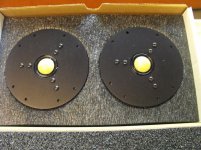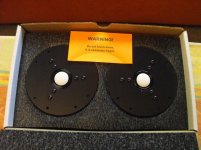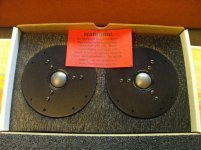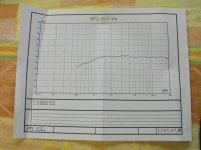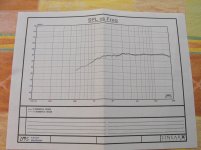Don't feel too frustrated. These are the most fragile dome tweeters I have ever used in over 30 years of speaker building. I have conducted a comparison of the Beryllium, Ceramic and kevlar dome tweeters from Transducer Labs with my long term reference silk dome ScanSpeak D2905-97000. They were paired with the midrange ScanSpeak 15W4531G00, crossover over at 3 kHz. Measured at the listening position (3.5 m) they are flat to 18 kHz with a slight –2 dB droop at 20 kHz, the limit of my RTA. Other plots I have seen typically shows that they recover above 25 kHz and start falling off around 40 kHz but up to 20 kHz they are similar to Revelator silk dome tweeters. As for the sound of the Beryllium, with the active crossover adjusted to as flat a response as I can obtain, the treble range sounds obvious. Always calling attention to itself. It gives a sort of Studio Monitor sound, every treble nuance is projected. I find it quite tiring to listen too. The treble should provide the correct level of harmonics to give instruments and voices a natural timbre. In this regard I prefer my reference ScanSpeak D2905-97000. The Ceramic and Kevlar versions similarly measure flat but paired with the ScanSpeak 15W4531G00 the treble range has less "body". I suspect that the smaller size of the Translab domes may have something to do with this. It makes the specs impressive but is that all that is required?Finally, the company responded to my request for reimbursement:
They will give me back the money
I'm very happy
Attachments
New Pictures on damage Tweeters


Those loose particles look like pieces of Beryllium. I think this is a serious safety issue for your health. I do hope it is not.
Mundorf AMT's are also very good choices, some of the smaller one's now on sale at Madisound.
I haven't heard Raal's but they are top notch guys!
E
I would not want to go through this again, so this time I'll go for a tweeter that is not delicate.
My project is a Poly Natalia, I already have the AUDAX HM130Z0 (old stock), I will replace the Audax HM210Z0 for a Audax HM210Z2.(Both are Aerogel Cone)
I would like a tweeter that gives a lot of air to the final sound.
what do you recomend me?
Interestingly this was on my list of candidates.
https://www.madisoundspeakerstore.c...fa-xt25tg30-04-1-ring-radiator-tweeter/#tab-1
Have you tried this?
Https://www.madisoundspeakerstore.c...b-acoustics-sb29rdc-c000-4-ring-dome-tweeter/
https://www.madisoundspeakerstore.c...fa-xt25tg30-04-1-ring-radiator-tweeter/#tab-1
Have you tried this?
Https://www.madisoundspeakerstore.c...b-acoustics-sb29rdc-c000-4-ring-dome-tweeter/
I would like a tweeter that gives a lot of air to the final sound.
what do you recomend me?
Every modern tweeter gives a lot of air if a speaker designer knows what to do with it. I have even tried a notoriously expensive Focal Be tweeter which is no better than a decent 100$ unit of similar specs. Much myth still around in audiophile community but slowly it's getting better and better.
No, air ( I guess...) is real air !
Probably it has something to do with "grain"
I mean, it's probably the natural hiss captioned by the mic that gives the sense
of natural ( or...not artificial/artified ) sound.
Air means spaciousness so also the captioned fine reverb given by the ambient.

Probably it has something to do with "grain"
I mean, it's probably the natural hiss captioned by the mic that gives the sense
of natural ( or...not artificial/artified ) sound.
Air means spaciousness so also the captioned fine reverb given by the ambient.
I think we need to agree on a definition of the terminology before we go further 
I would define "air" as a sensation that the higher frequencies present the reverberation amd sense of space in the recording realistically
In my experience this has more to do with wide off axis response in the horizontal plane rather than the shape of the direct frequency response
So if that is the case I would recommend a small diameter dome tweeter or ribbon/planar with a narrow radiating surface to the OP
I would define "air" as a sensation that the higher frequencies present the reverberation amd sense of space in the recording realistically
In my experience this has more to do with wide off axis response in the horizontal plane rather than the shape of the direct frequency response
So if that is the case I would recommend a small diameter dome tweeter or ribbon/planar with a narrow radiating surface to the OP
When i said frequency response i was reffering to averaged response in listening window - sorry for not being precise enough. What you're saying also sounds logical but i think that there isn't a deffinitive answer to what "more air" means to everyone, but what can be defined is what "more air" means to the OP - hence my "in most cases".
I would also define "air" as real air in the reproduction of high frequencies; a quick or short response in time of each high note, which gives space or air between notes.
(a similar effect than a tight bass compared to a loose bass)
I have read some capacitors give this effect, for example those of Coherent Audio, Audyn True Copper Cap, Murdof Supreme Gold Oil, Jantzen Audio Z-Silver. And Some Bypass Caps.
In my case the most air I've heard is in a Mini Magico (the only magico I've heard), asociates with a Gryphon, It sounds really really nice to me.
(a similar effect than a tight bass compared to a loose bass)
I have read some capacitors give this effect, for example those of Coherent Audio, Audyn True Copper Cap, Murdof Supreme Gold Oil, Jantzen Audio Z-Silver. And Some Bypass Caps.
In my case the most air I've heard is in a Mini Magico (the only magico I've heard), asociates with a Gryphon, It sounds really really nice to me.
If I were offer my suggestion it would be that 'airiness' is openness of the sound in general and not just pertaining to the higher frequencies but also to the upper midranges.
Harmonic distortion and refraction play a big part in the perception of 'airiness' in a sound field, so in selecting drivers with the lowest harmonic distortion in the upper registers and minimising refraction in the immediate vicinity of these drivers it will give that openness that is so desirable. A wide dispersion is also part of that mix.
C.M
Harmonic distortion and refraction play a big part in the perception of 'airiness' in a sound field, so in selecting drivers with the lowest harmonic distortion in the upper registers and minimising refraction in the immediate vicinity of these drivers it will give that openness that is so desirable. A wide dispersion is also part of that mix.
C.M
Last edited:
- Status
- This old topic is closed. If you want to reopen this topic, contact a moderator using the "Report Post" button.
- Home
- Loudspeakers
- Multi-Way
- Bad News
